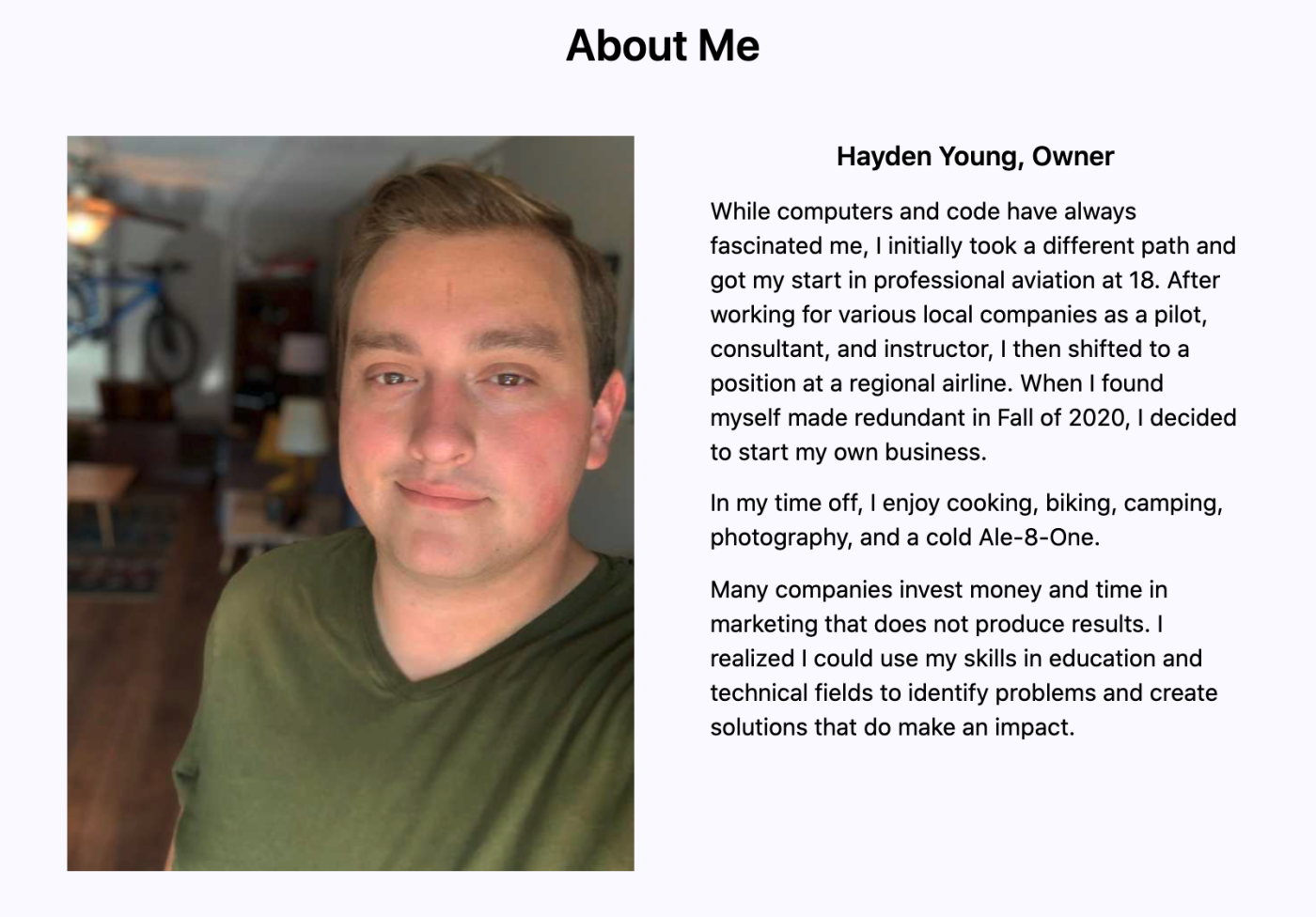When people talk about planning, it's often broken down into four types: strategic, operational, tactical, and contingency. I'm a business owner and a pilot, and all four types of planning are crucial for both of those roles. I'll get into that a little more, but first, I want to tell you a story.
The opposite of planning is complacency
Before I started my company, Deadhead.Design, I was an airline pilot and flight instructor.
One time, a fellow pilot and I planned a flight down to a local airport known for its food. The plan was for me to fly solo out of my home airport and pick them up on my way, at an airport closer to their house.
After my shift at the flight school that day, I completed my basic flight planning. This consists of weight and balance calculations and checking the weather and operational notices. I made the flight over to pick up my friend, and we headed to the destination. My buddy was a newer pilot, so I was mentoring a little during the flight. For example, I made a point of checking the weather before every departure. Don't get me wrong, you are absolutely supposed to do that regardless of your experience level, but...well, I'll tell the rest of the story.
We made the trip down and back (the food was as good as promised), and after a short delay dropping them off, I spun up the engine for the last time. The sun had just set on the Bluegrass, it was a lovely night, and I was looking forward to the quiet jump home.
In a combination of fatigue and complacency, I didn't consider checking the weather this time.
I should have. For starters, it's required. But beyond that, the sunset would have undoubtedly produced some change in the weather. And sure enough, that evening, the wind at altitude had picked up.
The departure took me out over a cliff at the end of the runway, where the wind was now very turbulent. I'd been confident I had a good picture of the situation, so it caught me off completely off guard. Less than a minute after departing, the airplane was violently shaking and hard to control.
My mind fell back to my training: aviate, navigate, communicate. I maintained control and track while communicating with the approach controller.
Was it a mechanical failure? What else could explain the rapid degradation in control authority?
As I was trying to work out what I could do to troubleshoot, it was over. Almost as fast as it started, I had flown out of the turbulence. I made some extra maneuvers performing flight control tests before making a normal approach. The response from the tower when I requested clearance to land: "November 123, cleared to land runway 22, be advised a CRJ-700 reported a 20-knot gain and loss on a 3-mile final."
I checked my airspeed and ground speed, finding a 35-knot discrepancy.
It all became clear: I didn't have any mechanical issues. My issue was, as the mechanics say, "located between the pilot's seat and the flight controls."
I got lucky. If I had checked the weather, I likely wouldn't even remember that flight now, years later. Some simple planning—very simple planning—would have put me in a much better position.
Small planning for small businesses
Any business owner can relate to this story. Not directly, of course, but think about all the times you've sat down with your accountant, a client, a vendor, or even a coworker. At least once, I bet, you missed something that was crystal clear in hindsight, right? We all do. That's why some amount of planning is vital, regardless of how minor a task is.
I now own my own web development and marketing consulting company. Not long ago, I sent a quote to a client that was an order of magnitude higher than I'd led the client to expect. I failed to do my planning on multiple levels before a client meeting and tried to just feel my way through it.
I'm sure everyone knows how that story ends.

Business plans, financial plans, or the planning and consideration around buying large-ticket items might feel obvious. But something as simple as jumping into a quick meeting with a vendor should be afforded some planning as well.
Think of it as checking the weather: what are you standing too close to the problem to see? This kind of small-scale planning helps establish situational awareness. You've already planned for the small stuff, so you're able to focus on what matters in the moment.
How big planning can help small planning
Let's take a look at the four kinds of planning I mentioned earlier, and how they can make your smaller-scale planning a lot simpler.
Strategic planning. Everything starts with strategic planning—looking years down the road. What's the big picture? You can think of this as planning for your planning, but you need to always revisit this level of planning as time passes and the environment changes. In the story of my flight, a strategic planning failure happened when I decided to make the trip after a long day at work and to conduct the last leg on my own. Had I made better strategic decisions, I probably would have ended up checking the weather.
Operational planning. In aviation, we have a standard operating procedure (SOP) for almost everything. It, like your operational planning, explains how to do something, not why. Businesses should also have SOPs. What are the actionable steps we need to take to get from here to there?
Tactical planning. The rubber is on the road now. How are the operational plans going to be executed? Tactical planning always uses the most up-to-date information and is the most specific type of planning. In business, this is usually project-based planning based on the unique needs of a project. You might even make a tactical plan before heading into a meeting to ensure the meeting serves to advance your other, higher-level plans. (You've probably already identified my failure to check the weather, or perform any tactical planning at all, as the ultimate failure on the last leg of my day.)
Contingency planning. All these plans we've come up with are great, but does anything really go down the way we expected it to? No. And that's where contingency planning comes in. One of the most common contingency plans I make with every client is what we'll do if we miss deadlines or budget. They really appreciate this kind of forethought, and in the cases when it does come up, they can relax a bit. Happy customers! In the airline industry, we have whole books of contingency plans pre-engineered for any situation. We often carefully discussed, step-by-step, what each member of the team would do if and when the play went left. And that's exactly why I made it through the turbulence.
The most important part: OODA
It's one thing to plan. It's another thing to act in a way that makes those plans worth something. If we don't remain attentive and flexible, the plan we worked hard to make is useless.
Colonel John Boyd of the U.S. Air Force pioneered a decision-making loop called OODA: observe, orient, decide, act. We aren't working in a vacuum, and if we don't constantly re-evaluate, our planning goes to waste. Observe the environment, orient yourself to what you see, decide how to respond, and then act. Then observe the result of your actions—and keep going through the loop.
Without planning, OODA won't do much good, but plans never go exactly the way you imagine, and OODA can help you adapt.
I hope you're as excited about planning as I am.
If so, don't keep those plans in your head. Write them down. Talk about them with coaches and employees, clients and vendors. You never know when someone is going to have a better idea than you—it might even be the new guy. Planning for the big stuff makes the small stuff easier. And planning for the small stuff makes the tiny stuff run like clockwork. Don't get complacent, or you'll end up with those face-palmy mistakes.
And, please, always check the weather.





